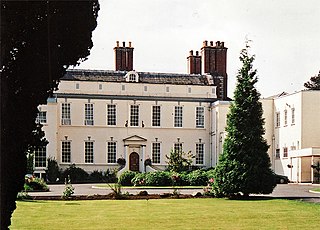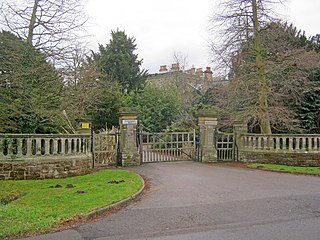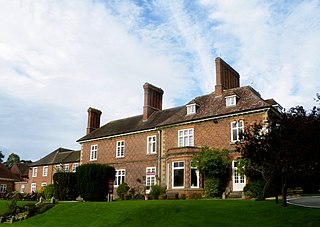Sir Charles William Rouse Boughton was an administrator in India with the East India Company and subsequently a member of the British House of Commons representing first Evesham and then Bramber.
Sir William Edward Rouse-Boughton, 2nd and 10th Baronet was a Member of Parliament for Evesham in Worcestershire.

Oakley Hall is an early 18th century 14,929 sf mansion house at Mucklestone, Staffordshire near to the Shropshire town of Market Drayton. It is a Grade II* listed building.
There have been two baronetcies created for members of the Boughton, later Rouse-Boughton family, one in the Baronetage of England and one in the Baronetage of Great Britain.

Wrottesley Hall is a 1923-built Grade II listed house in the civil parish of Perton, and historically part of Tettenhall in Staffordshire, England.

Brownsover Hall is a 19th-century mansion house in the old village of Brownsover, Rugby, Warwickshire which has been converted for use as a hotel. It is a Grade II* listed building.

Bilton Hall is a 17th-century mansion house in the Bilton area of Rugby, Warwickshire which has been converted into residential apartments. It is a Grade I listed building. It was once the home of the poet and essayist Joseph Addison and of the sporting writer Charles James Apperley.

Stanton Hall is a privately owned country house at Stanton in Peak in the Derbyshire Peak District, the home of the Davie-Thornhill family. It is a Grade II* listed building.

Peplow Hall is a privately owned 11,635 square feet (1,080.9 m2), 18th-century country house at Peplow, near Hodnet, Shropshire. It is the seat of The Waters family and is a Grade II* listed building.

Apley Hall is an English Gothic Revival house located in the parish of Stockton near Bridgnorth, Shropshire. The building was completed in 1811 with adjoining property of 180 acres (0.73 km2) of private parkland beside the River Severn. It was once home to the Whitmore & Foster families. The Hall is a Grade II* listed building claimed as one of the largest in the county of Shropshire.

Haughton Hall is an early 18th-century country house situated at Haughton Lane, Shifnal, Shropshire, England now converted for use as a hotel. It is a Grade II* listed building.

Downton Castle is a grade I listed 18th-century country house in the parish of Downton on the Rock in Herefordshire, England, situated about 5 miles (8.0 km) west of Ludlow, Shropshire.

Mawley Hall is a privately owned 18th-century country mansion near Cleobury Mortimer, Shropshire, England. It is a Grade I listed building.

Lockington Hall is a 17th-century country house, much improved and extended in later centuries, situated at Main Street, Hemington, Lockington, Leicestershire, and now converted to use as offices. It is a Grade II listed building.

Boughton Monchelsea Place, previously Boughton Court, is a 16th-century country house in Boughton Monchelsea, Kent, England. The first part of the house was built by Robert Rudston circa 1567–75 on the site of an earlier manor house. It has been modified a number of times during its history achieving its present form in 1819. It has been a home to a number of members of parliament for Maidstone or for Kent, including Sir Francis Barnham, Sir Robert Barnham (1646–85) Sir Barnham Rider (1698–1728) and Thomas Rider (1805–47).

Sudbrook Park in Petersham was developed by John Campbell, 2nd Duke of Argyll in the early 18th century. Sudbrook House, designed for Argyll by James Gibbs and now Grade I listed by Historic England, is considered a fine example of Palladian architecture. The house and its surrounding park have been the home of the Richmond Golf Club since 1891.

Charlotte Knight, known after her marriage as Charlotte, Lady Rouse-Boughton, was an English horticulturalist who bred the Waterloo cherry.

The Fishmore Hall Hotel in Ludlow, Shropshire is a house of historical significance. A major part of it was built in about 1820 but some of the building may be older than this. It was a private residence for many years and in the late part of the 20th century it became a school. It was recently converted to a hotel.

Richard Knight (1659–1745), of Downton Hall, in the parish of Downton on the Rock in Herefordshire, England, was a wealthy ironmaster who operated the Bringewood Ironworks, on the Downton estate, and founded a large fortune and family dynasty.

Albrighton Hall near Shrewsbury, Shropshire, is a house which is Grade II* listed on the National Heritage List for England. It was built in 1630 for the Ireland family and remained in this family for the next five generations until 1804. It was then the home of several notable people until 1953. In the 1990s it was converted into a hotel.

















